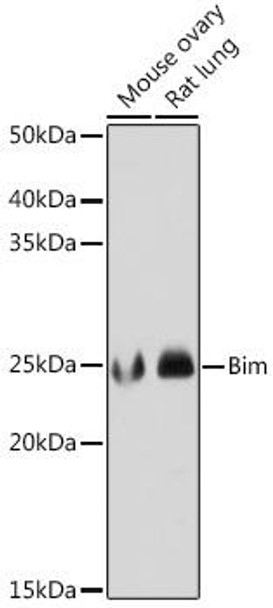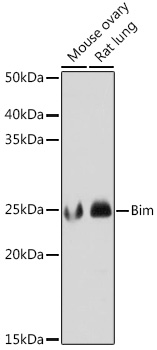Anti-Bim Antibody (CAB19702)
- SKU:
- CAB19702
- Product type:
- Antibody
- Reactivity:
- Human
- Reactivity:
- Mouse
- Reactivity:
- Rat
- Host Species:
- Rabbit
- Isotype:
- IgG
- Research Area:
- Cell Death
Description
| 抗体名: | Anti-Bim Antibody |
| 抗体コード: | CAB19702 |
| 抗体サイズ: | 20uL, 50uL, 100uL |
| 申し込み: | WB |
| 反応性: | Human, Mouse, Rat |
| 宿主種: | Rabbit |
| 免疫原: | A synthesized peptide derived from human Bim. |
| 申し込み: | WB |
| 推奨希釈: | WB 1:500 - 1:2000 |
| 反応性: | Human, Mouse, Rat |
| ポジティブサンプル: | Jurkat, HeLa, OVCAR3, Mouse lung, Mouse ovary, Rat lung |
| 免疫原: | A synthesized peptide derived from human Bim. |
| 精製方法: | Affinity purification |
| ストレージバッファ: | Store at -20°C. Avoid freeze / thaw cycles. Buffer: PBS with 0.02% sodium azide, 0.05% BSA, 50% glycerol, pH7.3. |
| アイソタイプ: | IgG |
| 順序: | Email for sequence |
| 遺伝子ID: | 10018 |
| Uniprot: | O43521 |
| セルラーロケーション: | |
| 計算された分子量: | 22kDa |
| 観察された分子量: | 22KDa |
| 同義語: | BAM, BIM, BOD, Bim, BCL2L11 |
| バックグラウンド: | The protein encoded by this gene belongs to the BCL-2 protein family. BCL-2 family members form hetero- or homodimers and act as anti- or pro-apoptotic regulators that are involved in a wide variety of cellular activities. The protein encoded by this gene contains a Bcl-2 homology domain 3 (BH3). It has been shown to interact with other members of the BCL-2 protein family and to act as an apoptotic activator. The expression of this gene can be induced by nerve growth factor (NGF), as well as by the forkhead transcription factor FKHR-L1, which suggests a role of this gene in neuronal and lymphocyte apoptosis. Transgenic studies of the mouse counterpart suggested that this gene functions as an essential initiator of apoptosis in thymocyte-negative selection. Several alternatively spliced transcript variants of this gene have been identified. [provided by RefSeq, Jun 2013] |
| UniProt Protein Function: | BIM: a pro-apoptotic member of the BCL-2 protein family. Interacts with other members of the BCL-2 protein family, including BCL2, BCL2L1/BCL-X(L), and MCL1, and act as an apoptotic activator. Its expression can be induced by nerve growth factor (NGF), as well as by the forkhead transcription factor FKHR-L1, which suggests a role in neuronal and lymphocyte apoptosis. Transgenic studies in the mouse suggested that this protein functions as an essential initiator of the apoptosis in thymocyte-negative selection. Nineteen alternatively spliced transcript variants of this gene have been reported. |
| UniProt Protein Details: | Protein type:Apoptosis Chromosomal Location of Human Ortholog: 2q13 Cellular Component: microtubule; mitochondrial outer membrane; extrinsic to membrane; endomembrane system; cytosol Molecular Function:protein binding; microtubule binding Biological Process: nerve growth factor receptor signaling pathway; positive regulation of apoptosis; apoptosis; cell-matrix adhesion; pigmentation during development; myeloid cell homeostasis; ear development; positive regulation of caspase activity; B cell apoptosis; cellular process regulating host cell cycle in response to virus; positive regulation of apoptosis by virus; mammary gland development; B cell homeostasis; positive regulation of neuron apoptosis; T cell homeostasis; kidney development; post-embryonic organ morphogenesis; caspase activation; spleen development; thymus development; in utero embryonic development; positive regulation of protein homooligomerization; male gonad development; positive regulation of cell cycle; regulation of organ growth; lumen formation; odontogenesis of dentine-containing teeth; DNA damage response, signal transduction resulting in induction of apoptosis; regulation of pigmentation during development; spermatogenesis; brain development |
| NCBI Summary: | The protein encoded by this gene belongs to the BCL-2 protein family. BCL-2 family members form hetero- or homodimers and act as anti- or pro-apoptotic regulators that are involved in a wide variety of cellular activities. The protein encoded by this gene contains a Bcl-2 homology domain 3 (BH3). It has been shown to interact with other members of the BCL-2 protein family and to act as an apoptotic activator. The expression of this gene can be induced by nerve growth factor (NGF), as well as by the forkhead transcription factor FKHR-L1, which suggests a role of this gene in neuronal and lymphocyte apoptosis. Transgenic studies of the mouse counterpart suggested that this gene functions as an essential initiator of apoptosis in thymocyte-negative selection. Several alternatively spliced transcript variants of this gene have been identified. [provided by RefSeq, Jun 2013] |
| UniProt Code: | O43521 |
| NCBI GenInfo Identifier: | 20336315 |
| NCBI Gene ID: | 10018 |
| NCBI Accession: | NP_619527.1 |
| UniProt Secondary Accession: | O43521,O43522, Q0MSE7, Q0MSE8, Q0MSE9, Q53R28, Q6JTU6 Q6T851, Q6TE14, Q6TE15, Q6TE16, A8K2W2, |
| UniProt Related Accession: | O43521 |
| Molecular Weight: | 22,171 Da |
| NCBI Full Name: | bcl-2-like protein 11 isoform 1 |
| NCBI Synonym Full Names: | BCL2-like 11 (apoptosis facilitator) |
| NCBI Official Symbol: | BCL2L11 |
| NCBI Official Synonym Symbols: | BAM; BIM; BOD |
| NCBI Protein Information: | bcl-2-like protein 11; bcl-2 interacting protein Bim; bcl-2-related ovarian death agonist; bcl-2 interacting mediator of cell death |
| UniProt Protein Name: | Bcl-2-like protein 11 |
| UniProt Synonym Protein Names: | Bcl2-interacting mediator of cell death |
| Protein Family: | Bcl-2-like protein |
| UniProt Gene Name: | BCL2L11 |
| UniProt Entry Name: | B2L11_HUMAN |


